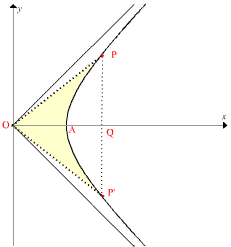Definizione geometrica
Data l’iperbole equilatera di equazione `x^2 - y^2 = a^2` avente per asintoti le rette `y = x` ed `y = -x` e semiasse reale `a`.
Su uno dei due rami consideriamo un punto `P` di coordinate `x ; y`.
Si ha quindi:
`OA = a` , `OQ = x` , `PQ = y`.

Indicato con `r` il rapporto tra l’area del triangolo mistilineo `S_(OPAP^’)` e quella del quadrato di lato `OA`, `r = S_(OPAP^’) / a^2`, si definiscono le funzioni iperboliche:
`sinh r = y/a` ;
`cosh r = x/a` ;
`tanh r = y/x`,
e le funzioni iperboliche inverse:
`csch r = a/y` ;
`sech r = a/x` ;
`coth r = x/y`.
Nel caso in cui a = 1 le relazioni diventano:
`sinh r = y` ; `cosh r = x` ; `tanh r = y/x`,
e le funzioni iperboliche inverse:
`csch r = 1/y` ; `sech r = 1/x` ; `coth r = x/y`.
Forma esponenziale
Per conoscere i valori che le funzioni iperboliche assumono al variare di `r`, è utile esprimerle in forma esponenziale.
`sinh r = (e^r - e^-r) / 2` ; `cosh r = (e^r + e^-r) / 2` ; `tanh r = (e^r - e^-r) / (e^r + e^-r)` ;
`csch r = 2 / (e^r - e^-r) = (2e^r) / (e^(2r) - 1)` ; `sech r = 2 / (e^r + e^-r) = (2e^r) / (e^(2r) + 1)` ; `coth r = (e^r + e^-r) / (e^r - e^-r) = (e^(2r) + 1) / (e^(2r) - 1)` .
È ora possibile definire sei funzioni iperboliche del tipo `y = f(x)`, ove `x` ha lo stesso significato di `r`.
`y = sinh x = (e^x - e^-x) / 2` ; `y = cosh x = (e^x + e^-x) / 2` ; `y = tanh x = (e^x - e^-x) / (e^x + e^-x)` ;
`y = csch x = 2 / (e^x - e^-x)` ; `y = sech x = 2 / (e^x + e^-x)` ; `y = coth x = (e^x + e^-x) / (e^x - e^-x)` .
Relazioni fondamentali
`cosh^2 x - sinh^2 x = 1`
`tanh x = (sinh x) / (cosh x)`
`csch x = 1 / (sinh x)`
`sech x = 1 / (cosh x)`
`coth x = 1 / (tanh x) = (cosh x) / (sinh x)`
In base a queste relazioni è possibile esprimere ogni funzione iperbolica in funzione delle altre:
| `sinh x` | `cosh x` | `tanh x` | `csch x` | `sech x` | `coth x` | |
|---|---|---|---|---|---|---|
| `sinh x` | `sinh x` | `+-sqrt(cosh^2 x-1` | `(tanh x) / sqrt(1 - tanh^2 x` | `1 / (csch x)` | `(+- sqrt(1 - sech^2 x)) / (sech x)` | `1 / (+-sqrt(coth^2 x - 1))` |
| `cosh x` | `sqrt(1 + sinh^2 x` | `cosh x` | `1 / sqrt(1 - tanh^2 x)` | `(+- sqrt(1 + csch^2 x)) / (csch x)` | `1 / (sech x)` | `(coth x) / (+-sqrt(coth^2 x - 1))` |
| `tanh x` | `(sinh x) / sqrt(1 + sinh^2 x` | `(+-sqrt(cosh^2 x - 1)) / (cosh x)` | `tanh x` | `1 / (sqrt(1 + csch^2 x)` | `(+- sqrt(1 - sech^2 x))` | `1/ (coth x)` |
| `csch x` | `1 / sinh x` | `1 / (+-sqrt(cosh^2 x - 1))` | `sqrt(1 - tanh^2 x) / (tanh x)` | `csch x` | `(sech x) / (+-sqrt(1 - sech^2 x))` | `+- sqrt(coth^2 x - 1)` |
| `sech x` | `1 / (sqrt(1 + sinsh^2 x))` | `1 / (cosh x)` | `sqrt(1 - tanh^2 x)` | `(csch x) / (+-sqrt(1 + csch^2 x))` | `sech x` | `(+- sqrt(coth^2 x - 1)) / (coth x)` |
| `coth x` | `(sqrt(1 + sinh^2 x)) / (sinh x)` | `(cosh x) / (+-sqrt(cosh^2 x - 1))` | `1 / (tanh x)` | `sqrt(1 + csch^2 x)` | `1 / (+- sqrt(1 - sech^2 x))` | `coth x` |
Prendere il segno (`+`) o (`-`) a seconda che sia `x>0` oppure `x<0`.
Relazioni di simmetria
`sinh (-x) = - sinh x` ; `cosh (-x) = cosh x` ; `tanh (-x) = - tanh x`.
`csch (-x) = - csch x` ; `sech (-x) = sech x` ; `coth (-x) = - coth x`.
Formule di duplicazione
`sinh 2x = 2 sinh x cosh x`
`cosh 2x = cosh^2 x + sinh^2 x =` `2 cosh^2 x - 1 =` `1 + 2 sinh^2 x`
Funzioni iperboliche inverse
Delle sei funzioni iperboliche si possono definire le corrispondenti funzioni inverse.
`y = arc sinh x` con `-oo < x < +oo` e `-oo < y < +oo`
`y = arc cosh x` con `1 <= x < +oo` e `0 <= y < +oo`
`y = arc tanh x` con `-1 < x < +1` e `-oo < y < +oo`
`y = arc csch x` con `{(-oo < x < 0), (0 < x < +oo):}` e ` {(-oo < y < 0), (0 < y < +oo):}`
`y = arc sech x` con `0 < x <= +1` e ` 0 <= y < +oo`
`y = arc coth x` con `{(-oo < x < -1), (1 < x < +oo):}` e ` {(-oo < y < 0), (0 < y < +oo):}`
Definizione logaritmica
`arc sinh x = log(x+sqrt(x^2+1))` per ` AA x in RR`
`arc cosh x = log(x+sqrt(x^2-1))` con ` x >= 1`
`arc tanh x = 1/2 log((1+x)/(1-x))` con `-1 < x < 1`
`arc csch x = {(log ((1+sqrt(1+x^2)) / (x)), if x > 0), (log ((1-sqrt(1+x^2)) / (x)), if x < 0):}`
`arc sech x = log((1+sqrt(1-x^2))/(x))` con `0 < x <= 1`
`arc coth x = 1/2 log((x+1)/(x-1))` con `x <-1 vv x > 1`